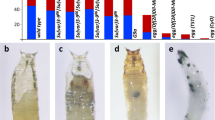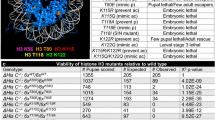Abstract
The dominant mutation Su-var(2)1 01which suppresses position-effect variegation and displays recessive butyrate sensitivity was found to result in significant hyperacetylation of histone H4. This biochemical finding, as well as the genetic properties of this mutation, strongly suggest that the wild-type product of the corresponding locus is involved in histone H4 deacetylation. In larvae containing the suppressor mutation the accessibility of chromatin to endogenous nucleases is significantly increased which might be causally connected with histone H4 hyperacetylation. The suppressor mutation Su-var(2)1 01has, therefore, to be classified as a chromatin condensation mutation.
Similar content being viewed by others

References
Baker WK (1968) Position-effect variegation. Adv Genet 1:133–169
Bellard M, Kuo MT, Dretzen G, Chambon P (1980) Differential nuclease sensitivity of the ovalbumin and β-globin chromatin region in erythrocytes and oviduct cells of laying hen. Nucleic Acids Res 8:2737–2750
Billings PC, Orf JW, Palmer DK, Talmage DA, Pan CG, Blumenfeld M (1979) Anomalous electrophoretic mobility of Drosophila phosphorylated H1 histone: is it related to the compaction of satellite DNA into heterochromatin? Nucleic Acids Res 6:2151–2164
Boffa LC, Gruss RJ, Allfrey VG (1981) Manifold effects of sodium butyrate on nuclear functions. J Biol Chem 256:9612–9621
Candido EPM, Reeves R, Davie JR (1978) Sodium butyrate inhibits histone deacetylation in cultured cells. Cell 14:105–113
Davie JR, Candido EPM (1978) Acetylated histone H4 is preferentially associated with template active chromatin. Proc Natl Acad Sci USA 75:3574–3577
Doenecke D, Gallwitz D (1982) Acetylation of histones in nucleosomes. Mol Cell Biochem 44:113–128
Elgin SCR, Weintraub H (1975) Chromosomal proteins and chromatin structure. Annu Rev Biochem 44:725–774
Garel A, Axel R (1976) Selective digestion of transcriptionally active ovalbumin genes from oviduct nuclei. Proc Natl Acad Sci USA 73:3966–3970
Giancotti V, Russo E, Cristini F, Graziosi G, Micali F, Crane-Robinson C (1984) Histone modification in early and late Drosophila embryos. Biochem J 218:321–329
Gottesfeld JM, Garrard WT, Bagi G, Wilson RF, Bonner J (1974) Partial purification of template active fraction of chromatin. Preliminary report. Proc Natl Acad Sci USA 71:2193–2197
Heymann S (1983) Untersuchungen zur Faserorganisation und Transkriptionsaktivität von dekondensiertem Chromatin aus Rattenleber. Prom A Akad der Wissensch der DDR, Berlin
Holmgren P, Rasmuson B, Johansson T, Sundquist G (1976) Histone content in relation to amount of heterochromatin and developmental stage in three species of Drosophila. Chromosoma 54:99–116
Laemmli UK (1970) Cleavage of structural proteins during the assembly of the head of bacteriophage T4. Nature 227:680–685
Lindsley DL, Grell EM (1968) Genetic variations of Drosophila melanogaster. Carnegie Inst Washington Publ 627
Mottus R, Reeves R, Grigliatti TA (1980) Butyrate suppression of position-effect variegation in Drosophila melanogaster. Mol Gen Genet 178:465–469
Oliver D, Chalkley R (1972) An electrophoretic analysis of Drosophila histones. I. Isolation and identification Exp Cell Res 73:295–302
Panyim S, Chalkley R (1969) High-resolution acrylamide gel electrophoresis of histones. Arch Biochem Biophys 130:337–346
Reeves R (1984) Transcriptionally active chromatin. Biochim Biophys Acta 782:343–393
Reuter G, Wolff I (1981) Isolation of dominant suppressor mutations for position-effect variegation in Drosophila melanogaster. Mol Gen Genet 182:516–519
Reuter G, Werner W, Hoffmann HJ (1982a) Mutants affecting position-effect heterochromatinization in Drosophila melanogaster. Chromosoma 85:539–551
Reuter G, Dorn R, Hoffmann HJ (1982b) Butyrate sensitive suppressor of position-effect variegation mutations in Drosophila melanogaster. Mol Gen Genet 188:480–485
Reuter G, Dorn R, Wustmann G, Friede B, Rauh G (1986) Third chromosome suppressor of position-effect variegation loci in Drosophila melanogaster. (submitted)
Riggs MG, Whittaker RG, Neumann JR, Ingram VM (1977) N-Butyrate causes histone modification in HeLa and Friend erythroleukemia cells. Nature 268:462–464
Sealy L, Chalkley R (1978) The effect of sodium butyrate on histone modification. Cell 14:115–121
Sinclair DAR, Mottus R, Grigliatti TA (1983) Genes which suppress position-effect variegation in Drosophila melanogaster are clustered. Mol Gen Genet 191:326–333
Spofford JB (1976) Position-effect variegation in Drosophila melanogaster. In: Ashburner M, Novitski E (eds) The genetics and biology of Drosophila, vol 1c. Academic Press, New York, pp 955–1018
Author information
Authors and Affiliations
Rights and permissions
About this article
Cite this article
Dorn, R., Heymann, S., Lindigkeit, R. et al. Suppressor mutation of position-effect variegation in Drosophila melanogaster affecting chromatin properties. Chromosoma 93, 398–403 (1986). https://doi.org/10.1007/BF00285820
Received:
Revised:
Issue Date:
DOI: https://doi.org/10.1007/BF00285820



